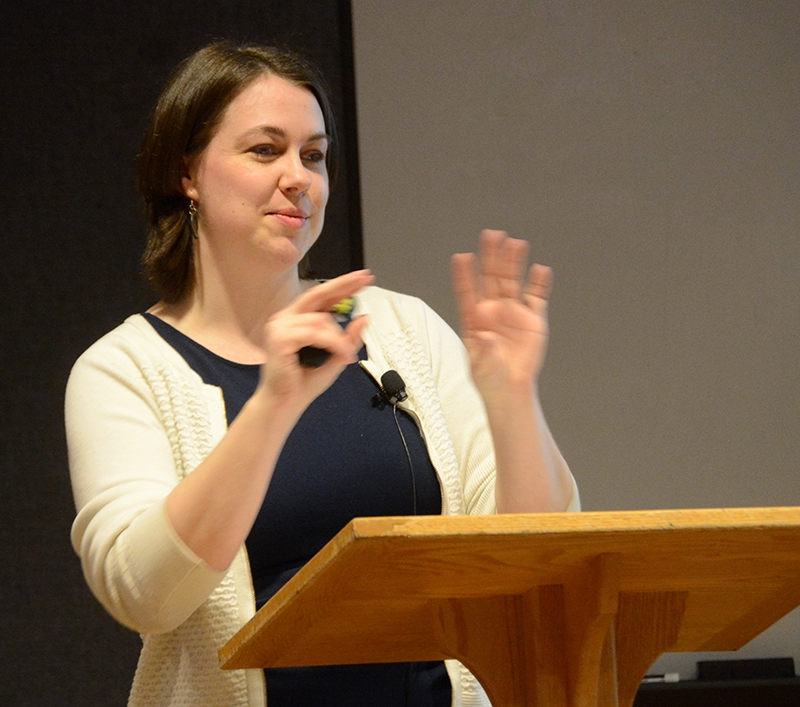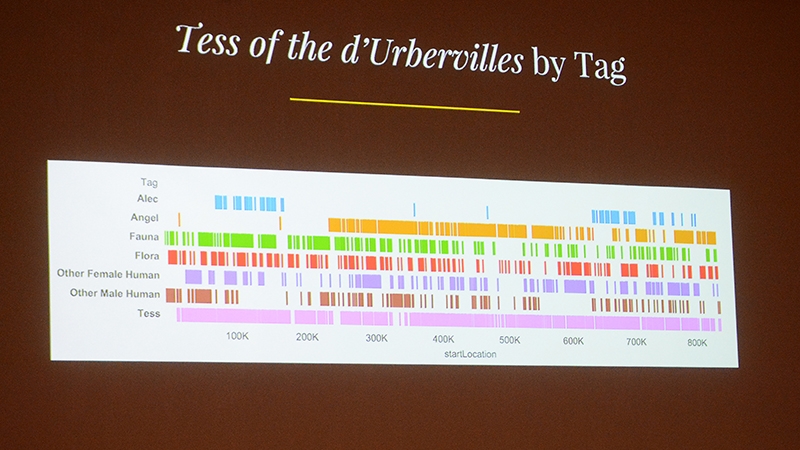Using Technology to Visualize the Natural World of Novels

MIDDLEBURY, Vt. – Middlebury’s postdoctoral fellow in the digital liberal arts, Alicia Peaker, offered new ways of analyzing literary classics as she shared the fruits of her latest research during the College’s Carol Rifelj Faculty Lecture Series on February 24.
Her talk was titled “Digital Readings and ‘Ferny, Mossy Discoveries’: Visualizing the Natural Worlds of Thomas Hardy’s Tess of the d’Urbervilles and Mary Webb’s Gone to Earth.”
Professor James Ralph, dean of faculty development and research, introduced Peaker and said the energetic scholar is “a wonderful ambassador for the digital liberal arts” who works closely with Middlebury faculty “to match, not force, digital approaches to their own scholarly work and teaching methods.”
With technology, Peaker has explored the relationship between the central characters and their natural environments in novels written by two British authors – authors who were influenced by the Romantic period in art and literature. Using computer-aided textual markup and analysis (CATMA) of every word contained in both books, Peaker has produced visualizations using Tableau Public data visualization software, Tagul word cloud generator, and other computer programs.
With every word from Hardy’s 1891 masterpiece loaded into the software, Alicia Peaker could “see,” for example, the frequency with which the name of the main character Tess appeared in the text and, moreover, she could determine the character’s proximity to words relating to flora (trees, flowers, etc.) and fauna (horse, cow, etc.). This research helped her represent “the ecosystems and biospheres” of the novel, and enabled her to develop “digital models for contextualizing human characters within the fictional worlds they inhabit.”

Peaker’s presentation was both an account of her attempts to adapt concepts from ecology to literary texts via technology, and her own reflection on what the process revealed about the novels and her own methods.
She compared “close reading” of literary works, which “has long been the primary method through which literary arguments are formed in scholarship,” with a new, highly digitized method called “distant reading,” which was developed by Franco Moretti at Stanford University.
“Both closeness and distance can be dangerous positions to occupy in relation to our environment,” said Peaker. “To be too close is to lose sight of the larger systems, and to be too distant is to remain outside.”
With a Ph.D. in English from Northeastern University, the speaker prefers to “think outside the binary of close and distant” in analyzing literature, particularly the 19th- and 20th-century British literature that greatly interests her.
By using technology to visualize the natural worlds of literature, Peaker hopes to “offer new modes of experiencing the environment that seek to connect readers and viewers not only to individual novels, but also to thinking about and attending to the environment themselves.”
In this way, her research (and the research of others using new technologies) could impact the ways in which literature of the environment is read and understood.
Visit Middlebury’s Digital Liberal Arts website for more about the initiative.

